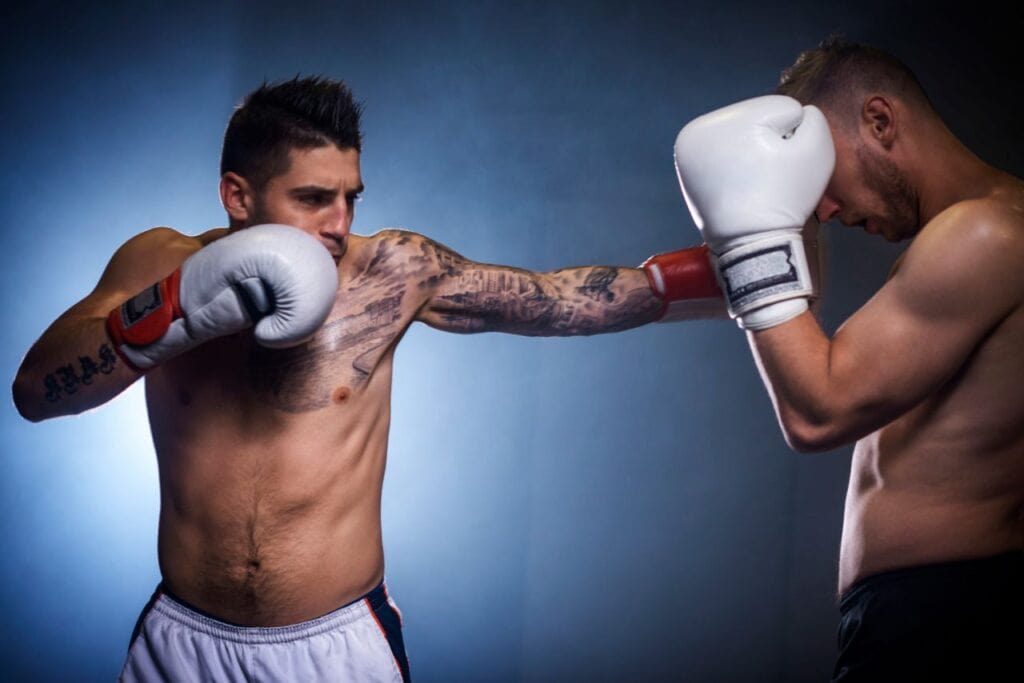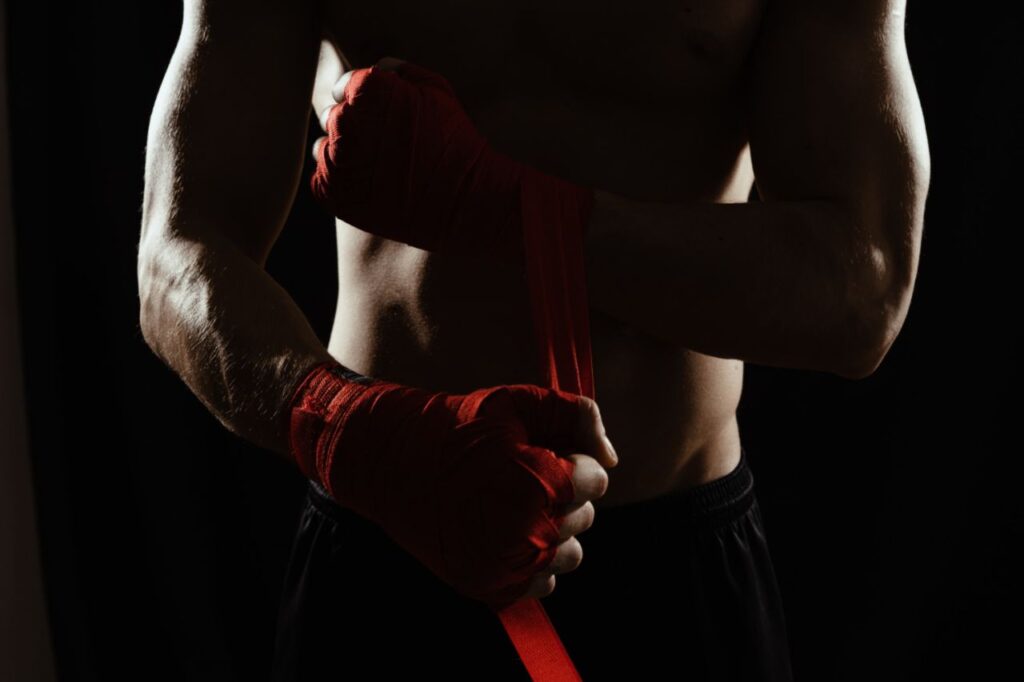Boxing is a demanding sport, both physically and mentally. It might seem a bit daunting at first, but I can assure you, it can be very rewarding as well.
Generally speaking, from the day you enter the gym and start training even three times a week, it would take about 6 months to really get the hang of the sport of boxing, but then again, it really depends on the individual.
Some people might need one or even 2 years to achieve the same results others got in just half a year. But, most of the time, it comes down to how dedicated you are to getting better – remember, training smart, not just hard, is what ultimately takes you to the next level.
For example, if you train five days a week but spar the same opponents all the time, you will eventually stop getting better – on the other hand, if you train three times a week but switch opponents as you get better, you will not stall on advancing further.
Making sure that you also train your strength and conditioning can help you progress faster and further.
But depending on the gym you train in, the coach might not let you spar other fighters for weeks or even months, and there’s a good reason for it.
You first have to learn the proper way to throw punches, move your feet, hit the heavy bag and mitts, hold your stance and such. In general, you have to know how the basic principles of boxing work before using them in a fight.
However, it can vary from person to person. Some might even take up to a couple of years to get the same result. Here are some factors that determine your progress.
How Long Does It Take To Get Good At Boxing?
It could take at least 1-2 years of regular training to get good at boxing. However, if you’ve learned and improved on the fundamentals and are moving into more advanced combinations and footwork, then you could be considered an intermediate and “good”.
But, it’s worth saying, “good” is a relative and subjective term! So, I may think a good Boxer could be pretty different from another.
Some Boxers (whether amateur or not) are great power punchers, and others are very hard to hit with amazing movement. They are both potentially “good” Boxers, but they have slightly different skillsets in the same sport of boxing.
The skills in boxing are much wider than throwing punches. There’s footwork, combinations, defence, slips, weaves, accuracy, power, and reading your opponent’s body language. Doing all of these well is what makes up a great Boxer.
To become a good, or even great, Boxer, you need to prioritize all the different areas of the sport to become effective and keep progressing until you reach a good stage.
You’ll know if you’re “good” when your trainer or coaches in group classes pick you out of the class to help demonstrate to the other students in the class. Of course, the first time it happens, it’s pretty exciting! But.. you know… stay humble.
Mistakes to Avoid as A Beginner
Arm Punches
A proper punch generates power from your lower body and legs rather than your arms. This ensures the transfer of weight from the base. Most beginners tend to move their hands towards their target. Instead, keep your knees slightly bent and twist your torso while punching to generate more power.
Excess Head Hunting
Landing a big punch on the head for that knockout can be tempting. Trust me, pro and amateur boxers have been there. But many newcomers often neglect the other scoring zones. Unfortunately, this also leaves them vulnerable. And that becomes their downfall.
So, you need always to mix up your combinations and go for those body punches. Eventually, your opponent will lower their guard. That’s the perfect time to go for the head.
Line of Sight
It’s crucial to maintain a line of sight while punching. Losing visuals on your opponent will leave you vulnerable to counterpunches. It’s always the one that you didn’t see that gets you. Practice maintaining eye contact with your opponent while punching or on defence.
Training Too Fast
Many forget that it’s more about the journey rather than the process. So never overtrain or rush on things. Instead, focus on the fundamentals and key skills. And, of course, enjoy the process. Otherwise, you’ll face burnout quite fast.
How To Train For Boxing
One of the most common questions that boxers often have is, “how do I set up my boxing routine and training?” Honestly, there is no easy answer to this question because it largely depends on the level of a boxer.
Boxing training will be different for beginners, somebody going for the first fight, a novice, open class, and pro fighters. Therefore, I will detail a range of training exercises that is insightful and beneficial for both beginners and fighters at different stages of boxing.

When looking at boxing from a general perspective, you are looking at 3 variables you want to build up in training; intensity, frequency, and volume.
- Intensity: This is how hard and fast you go, your movement per minute. It can also be described as work rate or punch output. One way of assessing your intensity is by using a heart monitor to see what round fatigue begins to creep in based on your work rate while training.
- Frequency: How many days per week do you train? For beginners, 3-4 days is advised. Advanced boxers can do 4-6 days a week.
- Volume: How many rounds per week shadowboxing, heavy bag, pad work, double-end bag, speed bag, partner drill, and freestyle and open drills. Intensity will dictate the volume, but generally, I’d recommend the following rounds: Beginners 40-60, Novice 60-80. Elite amateur 80-100, Pro Olympic 100+.
How To Get Good At Boxing In 6 Months
The first few weeks of your boxing journey can feel pretty discouraging. You’re constantly out of breath, every step feels strange, and your lead hand has all the concussive power of a cotton ball blowing in the breeze – it sucks, especially when there are 11 and 12-year old amateurs dancing circles around you every day. If they could, everyone would skip that awkward beginner phase.
In the book Outliers, Malcolm Gladwell wrote that it takes roughly 10,000 hours of practice to achieve mastery in any field. But what if there was a way to get good at boxing in 6 months?
You won’t hit the 10,000 hours needed for mastery – 24-hour, 7-day-per-week practice for 6 months only gets you 4464 in the bank, after all – but following these tips will help you hit more opponents, slip more punches, and at least get you a Bachelor’s Degree in the sweet science.
Some Tips To Progress Quickly In Boxing
We are not all made equally in our physical condition and shape, but if you want to progress quickly in boxing, we can all benefit from following these tips:
- Please have a good coach: a beginner’s mistake is to think that you can do it all yourself. A boxer with a good sports coach will progress up to three times faster than a beginner alone. You can avoid learning bad habits and adopt a good posture from the beginning.
- Don’t just train on a punching bag: the risk is not being attentive enough. The punching bag will not move, and it does not develop your reflexes, defence, or footwork. You cannot even work your uppercut. In short, you’ll have to vary your exercises to progress in all aspects of boxing.
- Don’t focus too much on power: another beginner’s mistake. When we focus only on power, it is at the expense of other essential skills in boxing, such as speed, endurance, precision or balance.
- Practice shadowboxing: punching the air or an imaginary opponent may seem silly, but it’s a great way to work out. It avoids injury and is a great cardiovascular exercise. Do it in front of a mirror to analyze your actions if you can.
- Respect your recovery time: allow yourself days off during the week. Your body needs it to repair the muscles and heal the aches between each training.
- Remember to practice finger exercises: with your fingerless gloves and sparring. They are usually more beneficial than just punching the bag or speed bag. They allow you to increase your heart rate and work your breath while gaining intensity and speed.
- Embrace old-school roadwork – or find other ways to build an aerobic base as soon as possible. While sprints and other forms of anaerobic conditioning are important parts of a complete training program, beginners who want to get good at boxing fast should emphasize slow-and-steady roadwork. Nobody likes this running style, at least at first – it is called road work for a reason. Unfortunately, those long, slow, steady-state jogs that got Rocky Marciano, Larry Holmes, and Muhammad Ali in shape are still one of the best ways to get better at boxing ASAP.
- Find a reliable training partner – or collect a whole stable. Everybody knows how important it is to locate a good boxing gym and trainer, but the importance of reliable training partners is often overlooked. Notice I said reliable and not incredible; your training partners don’t need to be great, or even good, so long as they’re showing up consistently and motivating you to do the same. You will learn proper technique from your coach, not your partner; what a partner does is accelerate the learning process by keeping your training “sport-specific” and getting you in the gym more often. It’s much easier to learn your range, practice targeting, and polish your defence when you have a real person to probe at with jabs, place body shots on, and frustrated with your head movement.
How To Track Your Progress For Boxing Training
We are all guilty of not doing many things in life, tracking our progress. Especially when it comes to training. With boxing training, in particular, it is no different as many don’t have a clue where to start!
What should you do? How often should you train? I’m I improving? Am I getting fitter and stronger?
In this article, I’ll give you some tips and advice on ways you can track your progress, whether you are a beginner or more advanced.
Physical and Skills
Now when it comes to boxing, there are two main areas that you will need to keep on top of. The first is much easier to track, and that is, of course, physical conditioning. There are many different ways to track this through the following:
- Through monitoring weight
- How many punches do you throw?
- Tracking amount of weight lifted (strength and conditioning)
- Journal your progress and what skills you are learning.
Skills and technique improvement is a bit more difficult to track, but I will go into more detail on this below on how you can track it.
Making a plan and schedule
You must follow a proper plan for your boxing training! If you do this, you will be much better positioned to perform at a higher level.
Suppose you plan on also doing strength and conditioning and are training 5-6 days a week. I recommend a max of only 2-3 days at most.
If you are only training 4-5 days a week with boxing training, only do 2 days of S&C.
S&C sessions should also not clash with your boxing training days or if you do, make sure it is after your technical training. For example, boxing training in the morning weight strength and conditioning in the afternoon.
Track your progress
Regardless of the type of progress you track, start a habit of setting daily, weekly, or monthly check-ins. Wearable devices, such as Punch Trackers, can give valuable feedback on boxing statistics.
These trackers can tell you average punch speed, number of punches, and more. Alternatively, you can wear a heart rate monitor to see improvements over time.
Depending on your training goal, you will want to track your progress to ensure effective workouts.
Keep a “feel good” journal
It seems so simple, right? By keeping a workout journal, you can physically see your continuous workouts. Maybe one week just wasn’t your week, and you can see that reflected in fewer reps or shorter workouts.
Your intention for the next week was to make a comeback from that previous week -- you set two PRs (personal records) and found a new exercise that you liked. Make sure to keep track of how you’re feeling rather than just the number on the scale.
If you find that you’re continuously doing the same workouts or staying constant, then you know that it may be time to switch things up and challenge yourself.
A workout journal can seem intimidating as it is all in front of you, and there is no way to hide from it.
It certainly can be if you allow it to be a tool and a friend.
Take Pictures.
When we say pictures, don’t take pictures that are “insta worthy” or a selfie. Take a Day 1 picture and pictures throughout your progress to help you see that you are indeed making progress as we can be our most harsh critics.
It can be scary and daunting, we know.
Sometimes we can get caught up in all of it that we don’t take note of how far we’ve come or how much farther we want to go.
It is key to ensure that pictures do not become a form of self-doubt or neglect.

On the contrary, it is supposed to enhance your hard work. You are the one who spends the most time with yourself -- be nice.
Conclusion
The sport of boxing is challenging but rewarding as well. You can certainly learn boxing within half a year in ideal circumstances. But in most cases, it will take about a year or so.
Staying dedicated, training smart, going to the gym best suited for you will make the process much faster.
Well, now you’ve got an idea of how long it takes to learn boxing. So, with that being said, it’s time to put on the boxing gloves.
FAQs
Can You Learn Boxing In 3 Months?
The basics of boxing can be learned relatively quickly. It should take no more than a couple of months to learn the most basic techniques in boxing. However, it takes months to years of practice to fully learn how to apply and use proper footwork and avoid punches.
How Long Should A Beginner Boxer Train?
Boxing usually takes between 4 to 12 months before the first fight. After that, fighters generally spend about 3-5 hours working out 5 times a week. But you don’t need to rush up. The longer you train and get well prepared will give you more chances of a successful debut.
Is boxing easy to learn?
Boxing is easy to pick up but hard to master. So many people go into training not knowing what to do, and if they aren’t taught the right techniques, they can develop bad habits that are hard to get rid of.
What Is The Best Age To Start Boxing?
Best Age to Start
Specialists in sports medicine believe that boxing classes are better to start 9-10 years. However, starting too early could put the student off, as boxing is hard work and not always as fun as team sports, such as football or rugby.
Is It Difficult To Get Into Boxing?
The path to becoming a pro boxer is very difficult. You’ll need to train hard to develop your strength, repeatedly win at the amateur level and keep your body in excellent physical condition. The majority of your professional life will be spent in the boxing gym.
- Find a gym. Boxing gyms aren't typically found in the yellow pages, but there are resources on the internet that can lead you in the right direction. ...
- Be sure the gym is within striking distance. ...
- Be open-minded. ...
- Choose your coach carefully. ...
- Do judge the gym by its cover.
So, can boxing be self-taught? Boxing can be self-taught but it's not the quickest and most effective way to become better at the sport because you aren't able to tap into the knowledge of a boxing coach who would be able to help you one to one.
Best Age to Start
Specialists in sports medicine believe that boxing classes are better to start from 9-10 years. Starting too early could result in putting the student off, as boxing is hard work and not always as fun as team sports, such as football or rugby.

